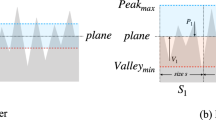Abstract
In this work, an attempt has been made to use a super resolution image processing algorithm for preprocessing the images over and above existing image quality enhancement techniques. The improved quality images processed using a machine vision system have been used to assess the quality of the surfaces. To ensure the validity of the approach the roughness values quantified using these images are then compared with widely accepted standard mechanical stylus instrument values. Quantification of digital images for surface roughness is performed using two Fourier transform parameters (major peak frequency and principal component magnitude squared value) and the standard deviation of gray level intensity values. Then the group method of data handling (GMDH) technique was used to obtain an analytical relationship of the roughness parameters calculated using the digital surface image and the stylus instrument values. We present in this paper an analysis based on the comparison to make sure that the present approach of estimation of surface finish based on the digital processed image could be implemented in practice.
Similar content being viewed by others
References
Kiran M, Ramamoorthy B, Radhakrishnan V (1998) Evaluation of surface roughness by vision system. Int J Mach Tool Manufact 38:685–690
Luk F, Hyunh V, North W (1989) Measurement of surface roughness by a machine vision system. J Phys E 22:977–980
Al-kindi GA, Baul RM, Gill KF (1992) An application of machine vision in the automated inspection of engineering surfaces. Int J Prod Res 2:241–253
Jason DG, Rourke JM, Bell AC (1984) High-speed surface roughness measurement. Transactions of ASME 34(106):34–39
Tsai DM, Tseng CF (1999) Surface roughness classification for castings. Pattern Recogn 32:389–405
Kartik A, Chandra S, Ramamoorthy B, Das S (1997) 3D tool wear measurement and visualization using stereo imaging. Int J Mach Tool Manufact 37:1573–1581
Rajneesh Kumar, Dhanasekar B, Ramamoorthy B (2005) Application of digital image magnification for surface roughness evaluation using machine vision. Int J Mach Tool Manufact 45:228–234
Lee BY, Tarng YS (2001) Surface roughness inspection by computer vision in turning operations. Int J Mach Tool Manufact 41:1251–1263
Younis MA (1998) On line surface roughness measurements using image processing towards an adaptive control. Comput. Ind. Eng. 35:49–52
Vandewalle P, Süsstrunk S, Vetterli M (2004) Double resolution from a set of aliased images. Proc. IS&T/SPIE Electronic Imaging 2004: Sensors and Camera Systems for Scientific, Industrial, and Digital Photography Applications: 5301
Irani M, Peleg S (1991) Improving resolution by image registration. CVGIP, Graph Models Image Process 53:231–239
Tsai RY, Huang TS (1984) Multiple frame image restoration and registration. Advances in Computer Vision and Image Processing:317–339
Park SM, Park MK, Kang MG (2003) Super-Resolution Image Construction: A Technical Overview. IEEE Signal Process Mag
Patti AJ, Ibrahim M, Tekalp AM (1997) Super resolution video reconstruction with arbitrary sampling lattices and nonzero aperture time. IEEE Trans Image Process 5:1064–1075
Liu S, Jernigan M (1990) Texture analysis and discrimination in additive noise. Comput Vis Graph Image Process 49(1):52–67
Ivakhenko AG (1971) Polynomial theory of complex systems. IEEE Trans Syst Man Cyb 1(4):364–378
Farlow SJ (1984) The GMDH algorithm, self-organizing methods in modeling. GMDH type algorithms
Keren D, Peleg S, Brada R (1988) Image sequence enhancement using sub-pixel displacement. Proceedings IEEE Conference on Computer Vision and Pattern Recognition:742–746
Papoulis A (1975) A new algorithm in spectral analysis and band-limited extrapolation. IEEE Trans Circuits Syst 22(9):735–742
Marcel B, Briot M, Murrieta R (1997) Calcul de translation et rotation par la transformation de Fourier. Traitement du signal 14:135–149
Vandewalle P, Susstrunk S, Vetterli M (2003) Superresolution images reconstructed from aliased images. SPIE/IS & T Visual Communication and Image Processing Conference 5150:1398–1405
Author information
Authors and Affiliations
Corresponding author
Rights and permissions
About this article
Cite this article
Dhanasekar, B., Ramamoorthy, B. Assessment of surface roughness based on super resolution reconstruction algorithm. Int J Adv Manuf Technol 35, 1191–1205 (2008). https://doi.org/10.1007/s00170-006-0799-5
Received:
Accepted:
Published:
Issue Date:
DOI: https://doi.org/10.1007/s00170-006-0799-5




